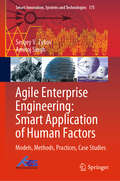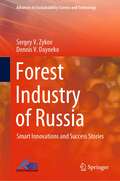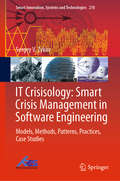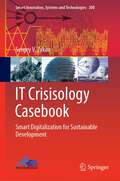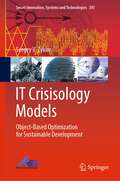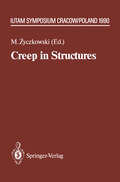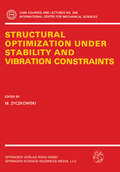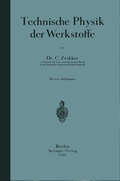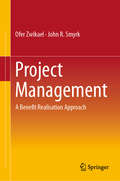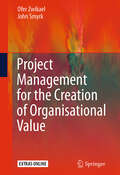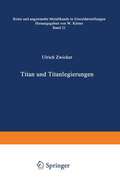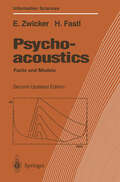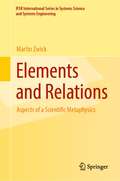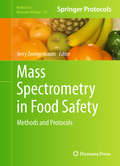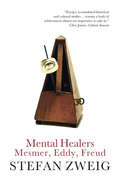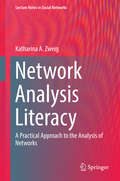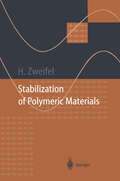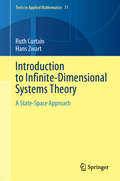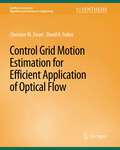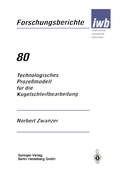- Table View
- List View
Agile Enterprise Engineering: Models, Methods, Practices, Case Studies (Smart Innovation, Systems and Technologies #175)
by Sergey V. Zykov Amitoj SinghThis concise book provides a survival toolkit for efficient, large-scale software development. Discussing a multi-contextual research framework that aims to harness human-related factors in order to improve flexibility, it includes a carefully selected blend of models, methods, practices, and case studies. To investigate mission-critical communication aspects in system engineering, it also examines diverse, i.e. cross-cultural and multinational, environments. This book helps students better organize their knowledge bases, and presents conceptual frameworks, handy practices and case-based examples of agile development in diverse environments. Together with the authors’ previous books, "Crisis Management for Software Development and Knowledge Transfer" (2016) and "Managing Software Crisis: A Smart Way to Enterprise Agility" (2018), it constitutes a comprehensive reference resource adds value to this book.
Forest Industry of Russia: Smart Innovations and Success Stories (Advances in Sustainability Science and Technology)
by Sergey V. Zykov Dennis V. DaynekoThis book focuses on crisis management in forest industry of Russia. It is about the present, and the future, with a short retrospective about the past of the forest industry in Russia. It includes forecasting too and description of some of the best practices of developed countries to be implemented in Russia to overcome the crisis. The main theme of the book is smart innovations and innovative activities introduced and also those which are required in the forest industry of Russia. The book considers the effectiveness of innovations and institutional changes in the forest industry, which are an important direction of innovation activities required all together with technological and economic breakthrough with ecological aspects in priority. The necessity to implement the modern innovation system in the forest industry based on institutional changes is substantiated and thoroughly explained with successful examples of ongoing and future up-to-date smart innovations. The development of the forest innovation system is suggested for sustainable forest industry management; the key components of which are technological, product, institutional, and ecological innovations, as well as, innovative entrepreneurship. Realization of the innovation system for technological and intellectual improvement requires good scientific and personnel provision, anticipation of markets and tendencies of development for some decades ahead. The implied advanced technologies in the forest industry also include IT-, nano-, and biotechnologies. The success stories of the leading Russian and international companies in the forest industry of Russia are studied attentively in the book. The book presents a profound methodical and theoretical substantiation for the further implementation of the smart innovations and of the successful experience of the industry leading companies.
IT Crisisology: Models, Methods, Patterns, Practices, Case Studies (Smart Innovation, Systems and Technologies #210)
by Sergey V. ZykovThis book focuses on crisis management in software development which includes forecasting, responding and adaptive engineering models, methods, patterns and practices. It helps the stakeholders in understanding and identifying the key technology, business and human factors that may result in a software production crisis. These factors are particularly important for the enterprise-scale applications, typically considered very complex in managerial and technological aspects and therefore, specifically addressed by the discipline of software engineering. Therefore, this book throws light on the crisis responsive, resilient methodologies and practices; therewith, it also focuses on their evolutionary changes and the resulting benefits.
IT Crisisology Casebook: Smart Digitalization for Sustainable Development (Smart Innovation, Systems and Technologies #300)
by Sergey V. ZykovThe book focuses on the real-world case-based crisis management in digital product development. This includes forecasting, responding, and agile engineering/management methods, patterns, and practices for sustainable development. This book introduces a set of case studies for sustainability in management as a blend, the components of which have been carefully selected from a few domains adjacent to digital production such as IT-intensive operation, human resource management, and knowledge engineering, to name a few. The key ingredients of this crisis management framework include information management, tradeoff optimization, agile product development, and knowledge transfer. The case studies this book features will help the stakeholders in understanding and identifying the key technology, business, and human factors that may likely result in a digital production crisis, i.e., critically affect the organization outcomes in terms of successful digitalization and sustainable development. These factors are particularly important for the large-scale applications, typically considered very complex in managerial and technological aspects, and, therefore, specifically addressed by the discipline of IT crisisology.
IT Crisisology Models: Object-Based Optimization for Sustainable Development (Smart Innovation, Systems and Technologies #381)
by Sergey V. ZykovThe book focuses on modeling real-world crisis management in digital product development. This includes models and methods for forecasting, responding, and agile engineering/managing for sustainable product development. This book suggests an approach that contains principles, formal models, and semi-formal practice-oriented methods, patterns and techniques to efficiently manage these crises and provide sustainable development. The book also introduces a set of principles, models, and methods for sustainable management as a blend, the components of which have been carefully selected from a few domains adjacent to digital production such as IT-intensive operation, human resource management, and knowledge engineering, to name a few. The key ingredients of this crisis management framework include smart data modeling, trade-off optimizing, agile product controlling, and knowledge transferring.
Creep in Structures: 4th IUTAM Symposium, Cracow, Poland September 10–14,1990 (IUTAM Symposia)
by Michal ZyczkowskiThere is a tradition to organize IUTAM Symposia "Creep in Structures" every ten years: the first Symposium was organized by N.J. Hoff in Stan ford (1960), the second one by J. Hult in Goteborg (1970), and the third one by A.R.S. Ponter in Leicester (1980). The fourth Symposium in Cracow, September 1990, gathered 123 par ticipants from 21 countries and reflected rapid development of the theory, experimental research and structural applications of creep and viscoplas ticity, including damage and rupture. Indeed, the scope of the Sympo sium was broad, maybe even too broad, but it was kept according to the tradition. Probably the chairman of "Creep in Structures V" in the year 2000 (if organized at all) will be forced to confine the scope substantially. Participation in the Symposium was reserved for invited participants, suggested by members of the Scientific Committee. Total number of sug gestions was very large and the response - unexpectedly high. Apart from several papers rejected, as being out of scope, over 100 papers were accepted for presentation. A somewhat unconventional way of presenta tion was introduced to provide ample time for fruitful and well prepared discussions: besides general lectures (30 minutes each), all the remain ing papers were presented as short introductory lectures (10 minutes) followed by a I-hour poster discussion with the authors and then by a general discussion. Such an approach made it possible to present general ideas orally, and then to discuss all the papers through and through.
Structural Optimization Under Stability and Vibration Constraints (CISM International Centre for Mechanical Sciences #308)
by M. ZyczkowskiOptimal design of structures leads, as a rule, to slender and thin-walled shapes of the elements, and such elements are subject to the loss of stability. Hence the constraints of structural optimization usually include stability constraints, expressed by some eigenvalues. Optimal design under vibration constraints belongs also to optimization with respect to eigenvalues. The present volume gives a short introduction to structural optimization and then pays particular attention to multimodal optimization under stability and vibration constraints, both in elastic and inelastic range. One part is devoted to thin-walled bars optimized for interactive buckling with imperfections taken into account. The volume is of interest both to researchers and design engineers: it covers the most recent results of multimodal and interactive optimization, allowing for inelastic behaviour of structures, and the constraints discussed appear in almost all problems of engineering design.
Intumescent Coatings for Fire Protection of Building Structures and Materials (Springer Series on Polymer and Composite Materials)
by Olga Zybina Marina GravitThe book provides practical recommendations for creation of fire retardant materials with an increased service life. The enhanced fire resistance seen in these materials is based on the regularities of the chemical and physicochemical interaction of the components of intumescent composition in the process of thermolytic synthesis of heat-insulating char-foamed layers. The aim of fire protection of various objects with intumescent materials is to create a heat-insulating charred layer on the surface of structural elements; this layer can withstand high temperatures and mechanical damage which are typical during fires. The authors describe the contribution of basic components (melamine, pentaerythritol, ammonium polyphosphate), additional components (chlorinated paraffin, urea, cellulose, carbon nano additives, etc.) and polymer binders of intumescent compositions on the process of charring. The technological aspects of manufacturing, application and operation of fire retardant intumescent compositions, which can be useful for organizations that produce and use fire retardant materials, are also described.
Technische Physik der Werkstoffe
by C. ZwikkerDieser Buchtitel ist Teil des Digitalisierungsprojekts Springer Book Archives mit Publikationen, die seit den Anfängen des Verlags von 1842 erschienen sind. Der Verlag stellt mit diesem Archiv Quellen für die historische wie auch die disziplingeschichtliche Forschung zur Verfügung, die jeweils im historischen Kontext betrachtet werden müssen. Dieser Titel erschien in der Zeit vor 1945 und wird daher in seiner zeittypischen politisch-ideologischen Ausrichtung vom Verlag nicht beworben.
Project Management: A Benefit Realisation Approach
by Ofer Zwikael John R. SmyrkThis book is a complete project management toolkit for project leaders in business, research and industry.Projects are approved and financed to generate benefits. Project Management: A Benefit Realisation Approach proposes a complete framework that supports this objective – from project selection and definition, through execution, and beyond implementation of deliverables until benefits are secured. The book is the first to explain the creation of organisational value by suggesting a complete, internally-consistent and theoretically rigorous benefit-focused project management methodology, supported with an analytical technique: benefit engineering. Benefit engineering offers a practical approach to the design and maintenance of an organisation’s project portfolio. Building upon the authors’ earlier successful book, Project Management for the Creation of Organisational Value, this comprehensively revised and expanded new book contains the addition of new chapters on project realisation. The book offers a rigorous explanation of how benefits emerge from a project. This approach is developed and strengthened — resulting in a completely client-oriented view of a project.Senior executives, practitioners, students and academics will find in this book a comprehensive guide to the conduct of projects, which includes robust models, a set of consistent principles, an integrated glossary, enabling tools, illustrative examples and case studies.
Project Management for the Creation of Organisational Value
by Ofer Zwikael John SmyrkProjects and programmes are approved and funded to generate benefits. Project Management for the Creation of Organisational Value proposes a complete framework that seeks to support such an objective – from project selection and definition, through execution, and beyond implementation of deliverables until benefits are secured.Because it is preoccupied with deliverables, accepted project management practice is flawed. Project Management for the Creation of Organisational Value proposes an alternative approach, which seeks a flow of target outcomes for the organisation investing in the project.Project Management for the Creation of Organisational Value provides support for all those who play a role of leadership in projects at different levels. Senior executives, practitioners and academics will find in this book a comprehensive guide to the conduct of projects and programmes, which includes robust models, a set of consistent principles, an integrated glossary, enabling tools, illustrative examples and case studies.A companion workbook to this text for instructors and students is available online at http://extras.springer.com. The workbook illustrates project management concepts using the approach presented in this book and contains a range of exercises.
Titan und Titanlegierungen (Reine und angewandte Metallkunde in Einzeldarstellungen #21)
by U. ZwickerPsychoacoustics: Facts and Models (Springer Series in Information Sciences #22)
by Eberhard Zwicker Hugo FastlPsychoacoustics - Facts and Models represents a comprehensive collection of data describing the processing of sound by the human hearing system. It includes quantitative relations between sound stimuli and auditory perception in terms of hearing sensations. In addition, quantitative psychoacoustic models of hearing sensations are given. The monograph contains a unique collection of data on the human hearing system as a receiver of acoustic information as well as many examples of the practical application of the results of basic research in fields such as audiology, noise evaluation, and sound engineering. Many helpful hints for the solution of practical problems will be of particular benefit to engineers, and the book as a whole should serve as an important benchmark in the field of psychoacoustics. The treatment given in this second edition has been thoroughly updated with recent results.
Elements and Relations: Aspects of a Scientific Metaphysics (IFSR International Series in Systems Science and Systems Engineering #35)
by Martin ZwickThis book develops the core proposition that systems theory is an attempt to construct an “exact and scientific metaphysics,” a system of general ideas central to science that can be expressed mathematically. Collectively, these ideas would constitute a nonreductionist “theory of everything” unlike what is being sought in physics. Inherently transdisciplinary, systems theory offers ideas and methods that are relevant to all of the sciences and also to professional fields such as systems engineering, public policy, business, and social work. To demonstrate the generality and importance of the systems project, the book structures its content in three parts: Essay, Notes, and Commentary. The Essay section is a short distillation of systems ideas that illuminate the problems that many types of systems face. Commentary explains systems thinking, its value, and its relation to mainstream scientific knowledge. It shows how systems ideas revise our understanding of science and how they impact our views on religion, politics, and history. Finally, Notes contains all the mathematics in the book, as well as scientific, philosophical, and poetic content that is accessible to readers without a strong mathematical background. Elements and Relations is intended for researchers and students in the systems (complexity) field as well as related fields of social science modeling, systems biology and ecology, and cognitive science. It can be used as a textbook in systems courses at the undergraduate or graduate level and for STEM education. As much of the book does not require a background in mathematics, it is also suitable for general readers in the natural and social sciences as well as in the humanities, especially philosophy.
Signal- und Rauschanalyse mit Quellenverschiebung: Elektronische Schaltungen grafisch gelöst
by Albrecht Zwick Jochen Zwick Xuan Phuc NguyenMit der Quellenverschiebung stellen die Autoren erstmals in deutscher Sprache eine äußerst praxistaugliche und verblüffend einfache grafische Methode zur Signal- und Rauschanalyse elektronischer Schaltungen vor. Sie führen kompetent, kompakt und praxisnah in das Rauschen elektronischer Bauelemente ein und stellen dessen Wirkungsweise in unterschiedlichen Schaltungen exemplarisch dar. Die Methode der Quellenverschiebung ermöglicht hierbei eine schnelle Abschätzung der wesentlichen Rauschanteile sowie eine Optimierung der Dimensionierung.
The BCS-BEC Crossover and the Unitary Fermi Gas (Lecture Notes in Physics #836)
by Wilhelm ZwergerRecent experimental and theoretical progress has elucidated the tunable crossover, in ultracold Fermi gases, from BCS-type superconductors to BEC-type superfluids. The BCS-BEC Crossover and the Unitary Fermi Gas is a collaborative effort by leading international experts to provide an up-to-date introduction and a comprehensive overview of current research in this fast-moving field. It is now understood that the unitary regime that lies right in the middle of the crossover has remarkable universal properties, arising from scale invariance, and has connections with fields as diverse as nuclear physics and string theory. This volume will serve as a first point of reference for active researchers in the field, and will benefit the many non-specialists and graduate students who require a self-contained, approachable exposition of the subject matter.
Mass Spectrometry in Food Safety: Methods and Protocols (Methods in Molecular Biology #747)
by Jerry ZweigenbaumAs a key component of human survival, a safe and sufficient food supply is essential for a healthy and productive population throughout the world, so assurance that the food supply is clean and free of harmful substances is a global concern. In Mass Spectrometry in Food Safety: Methods and Protocols, experts in the field provide context to the subject through reviews of regulations in various countries, the current state-of-the art, and specific, detailed scientific methods being employed today. The volume thoroughly covers the key areas in food safety, such as detection of low level chemical residues, pesticide analysis aided by chromatographic techniques, and the revealing of mycotoxins and chemical contaminants from packaging materials. Written in the highly successful Methods in Molecular Biology™ series format, method chapters contain introductions to their respective topics, lists of the necessary materials and reagents, step-by-step, readily reproducible laboratory protocols, and tips on troubleshooting and avoiding known pitfalls. Pertinent and cutting-edge, Mass Spectrometry in Food Safety: Methods and Protocols serves researchers with both understanding and appreciation for the contribution of mass spectrometry and its vital application to food testing and food safety.
Mental Healers: Mesmer, Eddy and Freud
by Stefan ZweigFranz Mesmer, Mary Baker Eddy and Sigmund Freud—three influential thinkers who travelled very different paths in their search for the crucial link between mind and body. Zweig's brilliant study explores the lives and work of these important figures, raising provocative questions regarding the efficacy and even the morality of their methods. An insight into the minds of three key thinkers who shaped the philosophy of our age, Mental Healers is a wonderfully intriguing and thought-provoking biographical work from a renowned master of the genre.
Network Analysis Literacy: A Practical Approach to the Analysis of Networks (Lecture Notes in Social Networks)
by Katharina A. ZweigThis book presents a perspective of network analysis as a tool to find and quantify significant structures in the interaction patterns between different types of entities. Moreover, network analysis provides the basic means to relate these structures to properties of the entities. It has proven itself to be useful for the analysis of biological and social networks, but also for networks describing complex systems in economy, psychology, geography, and various other fields. Today, network analysis packages in the open-source platform R and other open-source software projects enable scientists from all fields to quickly apply network analytic methods to their data sets. Altogether, these applications offer such a wealth of network analytic methods that it can be overwhelming for someone just entering this field. This book provides a road map through this jungle of network analytic methods, offers advice on how to pick the best method for a given network analytic project, and how to avoid common pitfalls. It introduces the methods which are most often used to analyze complex networks, e.g., different global network measures, types of random graph models, centrality indices, and networks motifs. In addition to introducing these methods, the central focus is on network analysis literacy – the competence to decide when to use which of these methods for which type of question. Furthermore, the book intends to increase the reader's competence to read original literature on network analysis by providing a glossary and intensive translation of formal notation and mathematical symbols in everyday speech. Different aspects of network analysis literacy – understanding formal definitions, programming tasks, or the analysis of structural measures and their interpretation – are deepened in various exercises with provided solutions. This text is an excellent, if not the best starting point for all scientists who want to harness the power of network analysis for their field of expertise.
Stabilization of Polymeric Materials (Macromolecular Systems - Materials Approach)
by Hans ZweifelPlastics are used worldwide in everyday life, e.g. as food packaging, electronics, construction, automotive parts, and household appliances. To produce these products with the desired service lifetimes the use of suitable stabilizers is necessary. This book provides a concise and comprehensive overview of the basic mechanisms of plastic degradation processes caused by heat and light. At its core is a detailed description of the stabilization of different polymers, including an explanation of stabilization mechanisms and the influence of commonly used additives such as fillers, flame retardents and pigments on the stability of plastic. Every polymer scientist, material technologist, or application engineer dealing with the design of the properties of plastics will benefit from this new overview.
Aufbruch ins Industriezeitalter – Zukunftswerkstätten der Neuzeit
by Gerhard ZweckbronnerWir leben in einer von Technik geprägten Welt. Dieses Sachbuch möchte ein Grundverständnis für technische Funktionsweisen und Zusammenhänge vermitteln. Es zeigt historische Entwicklungswege bis in die Gegenwart auf und macht deutlich, vor welche Entscheidungen wir heute gestellt sind. Wer sich in unserer hochtechnisierten Welt besser orientieren möchte, dem könnte ein Blick in die Zukunftswerkstätten der Vergangenheit helfen: jener Zeiten des Aufbruchs, in denen, ausgehend vom europäischen Kulturkreis, die mentalen und wissenschaftlich-technischen Grundlagen unserer modernen Lebenswelt geschaffen wurden. Kühne Fortschrittserwartungen, weit ausgreifende Visionen, aber auch warnende Stimmen begleiten die Entwicklung bis zum heutigen Tag.
Introduction to Infinite-Dimensional Systems Theory: A State-Space Approach (Texts in Applied Mathematics #71)
by Hans Zwart Ruth CurtainInfinite-dimensional systems is a well established area of research with an ever increasing number of applications. Given this trend, there is a need for an introductory text treating system and control theory for this class of systems in detail. This textbook is suitable for courses focusing on the various aspects of infinite-dimensional state space theory. This book is made accessible for mathematicians and post-graduate engineers with a minimal background in infinite-dimensional system theory. To this end, all the system theoretic concepts introduced throughout the text are illustrated by the same types of examples, namely, diffusion equations, wave and beam equations, delay equations and the new class of platoon-type systems. Other commonly met distributed and delay systems can be found in the exercise sections. Every chapter ends with such a section, containing about 30 exercises testing the theoretical concepts as well. An extensive account of the mathematical background assumed is contained in the appendix.
Control Grid Motion Estimation for Efficient Application of Optical Flow (Synthesis Lectures on Algorithms and Software in Engineering)
by Christine M. Zwart David FrakesMotion estimation is a long-standing cornerstone of image and video processing. Most notably, motion estimation serves as the foundation for many of today's ubiquitous video coding standards including H.264. Motion estimators also play key roles in countless other applications that serve the consumer, industrial, biomedical, and military sectors. Of the many available motion estimation techniques, optical flow is widely regarded as most flexible. The flexibility offered by optical flow is particularly useful for complex registration and interpolation problems, but comes at a considerable computational expense. As the volume and dimensionality of data that motion estimators are applied to continue to grow, that expense becomes more and more costly. Control grid motion estimators based on optical flow can accomplish motion estimation with flexibility similar to pure optical flow, but at a fraction of the computational expense. Control grid methods also offer the added benefit of representing motion far more compactly than pure optical flow. This booklet explores control grid motion estimation and provides implementations of the approach that apply to data of multiple dimensionalities. Important current applications of control grid methods including registration and interpolation are also developed. Table of Contents: Introduction / Control Grid Interpolation (CGI) / Application of CGI to Registration Problems / Application of CGI to Interpolation Problems / Discussion and Conclusions
Technologisches Prozeßmodell für die Kugelschleifbearbeitung (iwb Forschungsberichte #80)
by Norbert ZwanzerEnzymes in Action Green Solutions for Chemical Problems (NATO Science Partnership Subseries: 1 #33)
by Binne Zwanenburg Marian Mikolajczyk Piotr KielbasinskiEnzymes in Action is a timely survey of a modern development in organic chemistry. It is clear that bioreagents demand that organic chemists think in a different way. If they do so, they will open up new avenues of exciting, new chemistry that will permit problems to be solved in an elegant way. The first section covers the concepts necessary to understand enzymes in molecular operations. The second section covers heteroatom enzyme chemistry, with considerable attention being given to the use of enzymes in the detoxification of chemical warfare agents and their application in environmental problems. The final section highlights the strategic use of enzymes in organic chemistry. It is clear that the term `green chemistry' is appropriate, since enzyme mediated processes occur under mild, environmentally benign conditions, and enzymes enable chemists to perform new chemical operations that would otherwise be difficult to achieve at all.
